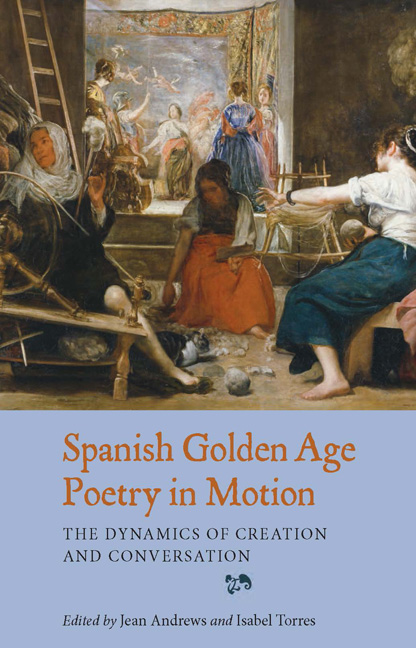Book contents
- Frontmatter
- Contents
- Contributors
- Acknowledgements
- Introduction
- 1 La poesía mutante del Siglo de Oro
- Part 1 Poetry in Creation
- 2 Moving in …Garcilaso de la Vega's ‘Dulces prendas por mi mal halladas’
- 3 The Movement of Thought and Feeling in the ‘Ode to Juan de Grial’
- 4 Metaphors of Movement in Two Poems of Fray Luis de León
- 5 El tiempo medido en versos: Camila Lucinda en las Rimas (1609) de Lope de Vega
- 6 Upwards to Helicon: Lope de Vega, the Laurel de Apolo, and Acts of Judgement
- 7 ‘Dulce es refugio’: El peregrino de Góngora se detiene
- 8 The Staging of Góngora's Three Funereal Sonnets for Margarita de Austria Estiria
- 9 Jealousy in María de Zayas's Intercalated Poetry: Lyric Illness and Narrative Cure
- 10 Hacia otra lectura del petrarquismo en Sor Juana Inés de la Cruz
- Part 2 Poetry in Conversation
- 11 El conde de Salinas y Leonor Pimentel: cuando se juntan el amor y la poesía
- 12 Poesía popular en movimiento: los jeroglíficos ‘muy propios al intento y muy de su profesión’ en las celebraciones de la Valencia barroca
- 13 Responding to Góngora: María Rosal and the Clori Poems
- 14 Traveling in Place: Baroque Lyric Transports in Translation, or Flames that Bridge the Stream
- Works Cited
- Index
9 - Jealousy in María de Zayas's Intercalated Poetry: Lyric Illness and Narrative Cure
Published online by Cambridge University Press: 05 November 2014
- Frontmatter
- Contents
- Contributors
- Acknowledgements
- Introduction
- 1 La poesía mutante del Siglo de Oro
- Part 1 Poetry in Creation
- 2 Moving in …Garcilaso de la Vega's ‘Dulces prendas por mi mal halladas’
- 3 The Movement of Thought and Feeling in the ‘Ode to Juan de Grial’
- 4 Metaphors of Movement in Two Poems of Fray Luis de León
- 5 El tiempo medido en versos: Camila Lucinda en las Rimas (1609) de Lope de Vega
- 6 Upwards to Helicon: Lope de Vega, the Laurel de Apolo, and Acts of Judgement
- 7 ‘Dulce es refugio’: El peregrino de Góngora se detiene
- 8 The Staging of Góngora's Three Funereal Sonnets for Margarita de Austria Estiria
- 9 Jealousy in María de Zayas's Intercalated Poetry: Lyric Illness and Narrative Cure
- 10 Hacia otra lectura del petrarquismo en Sor Juana Inés de la Cruz
- Part 2 Poetry in Conversation
- 11 El conde de Salinas y Leonor Pimentel: cuando se juntan el amor y la poesía
- 12 Poesía popular en movimiento: los jeroglíficos ‘muy propios al intento y muy de su profesión’ en las celebraciones de la Valencia barroca
- 13 Responding to Góngora: María Rosal and the Clori Poems
- 14 Traveling in Place: Baroque Lyric Transports in Translation, or Flames that Bridge the Stream
- Works Cited
- Index
Summary
María de Zayas's dynamic use of intercalated poetry in her Novelas amorosas y ejemplares (1637) and Parte segunda del Sarao y entretenimiento honesto (1647) provides us with a sustained example of ‘poetry in motion’ across hundreds of narrative pages. Over the course of these works, Zayas intersperses lyric forms in her narrative, creating generic contrasts that are integral to the structure of both books and offering evidence for the gradual transformation of her central character, Lisis.
As readers progress through the frame that enfolds and interconnects the twenty novellas of Zayas's two books, they follow the thread of the story of Lisis, the frame narrative's protagonist and, as some critics have suggested, Zayas's alter ego. Lisis first appears at the opening of the Novelas amorosas as a poet, weakened in body and mind because Don Juan has spurned her. As the sarao begins she is lying on her couch, sickened by the sort of early modern ‘amorous jealousy’ Steven Wagschal has defined as ‘a group of emotions, feelings, thoughts, bodily changes, and attitudes that are experienced in relation to guarding the exclusivity of a relationship that one possesses from a rival and/or avenging the loss of that which was possessed’. Through the course of the works as a whole, Lisis makes a systematic conversion from poet to narrator as well as from illness to health. She undergoes these changes in her mental and physical state as she overcomes Don Juan's rejection.
- Type
- Chapter
- Information
- Spanish Golden Age Poetry in MotionThe Dynamics of Creation and Conversation, pp. 147 - 164Publisher: Boydell & BrewerPrint publication year: 2014



